Products
-
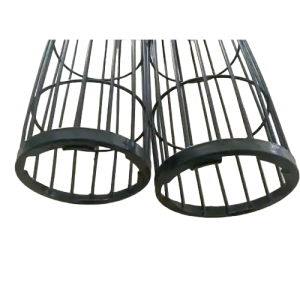
The collaborative work of dust removal filter bags and filter cages
The collaborative work of dust removal filter bags and filter cages
The dust removal filter bags and filter cages, as the core components of the dust removal system, work together to ensure the efficient and stable operation of the dust removal system. The filter cages provide solid support for the filter bags, ensuring that the filter bags maintain a stable shape under complex working conditions; the filter bags, relying on their excellent filtering performance, effectively intercept dust particles. Only when the two components are matched and their performances are coordinated can the dust removal system maximize its effect, reduce operating costs, and minimize dust pollution.
In practical applications, the materials, structures, installation, and maintenance of the dust removal filter bags and filter cages should be selected reasonably based on specific working conditions. At the same time, with the increasingly strict environmental requirements and the continuous development of industrial technology, higher performance requirements have been put forward for the dust removal filter components, driving the dust removal filter bags and filter cages towards higher efficiency, longer lifespan, and better resistance to harsh working conditions. For example, the development of new composite filter materials has improved the filtering efficiency and temperature and corrosion resistance of the filter bags; the structural optimization of the filter cages has further reduced weight, improved strength and corrosion resistance.In conclusion, a thorough understanding of the characteristics, collaborative working mechanism, and maintenance points of the dust removal filter bags and filter cages is of great practical significance for optimizing the design of industrial dust removal systems and improving the level of dust control. It helps to promote industrial production towards a more environmentally friendly and efficient direction.
-

Filter cage: The solid support for dust removal filter bags
The filter cage, also known as the filter bag frame, is an important component that supports the dust removal filter bags. Its main function is to maintain the shape of the filter bags and prevent them from deforming or being damaged due to force during filtration and dust cleaning. At the same time, it provides a smooth passage for the airflow. The quality and design rationality of the filter cage directly affect the service life of the filter bags and the operational stability of the dust removal system.
Structure and Material
The filter cage is usually in a circular or elliptical frame structure, welded by longitudinal and transverse ribs. It has a lifting cap or flange at the top, making it easy to install and fix. The number and diameter of the longitudinal and transverse ribs are determined according to the size of the filter bag and the working pressure to ensure that the filter cage has sufficient strength and rigidity.
The selection of the material for the filter cage needs to consider factors such as corrosion resistance, strength, and cost. Common materials include ordinary carbon steel, galvanized steel wire, and stainless steel. Ordinary carbon steel has a lower cost but poorer corrosion resistance, suitable for dry and non-corrosive environments; galvanized steel wire is treated with surface galvanization, improving corrosion resistance, and is widely used; stainless steel has excellent corrosion resistance and strength, suitable for harsh environments with high corrosion, but has a relatively higher cost.
Surface treatment process
To further enhance the corrosion resistance and service life of the filter cage, surface treatment is usually carried out. Common surface treatment processes include galvanization, powder coating, and chrome plating. Galvanization involves immersing the filter cage in molten zinc liquid to form a zinc coating on its surface, providing corrosion protection; powder coating involves spraying plastic powder on the filter cage surface and curing to form a uniform plastic coating, with good corrosion resistance and decorative properties; chrome plating forms a hard, wear-resistant, and corrosion-resistant chromium coating on the filter cage surface, suitable for occasions with high surface performance requirements.
Compatibility and Function with Filter Bags
The compatibility and function of the filter cage and the dust removal filter bags are crucial. The dimensions of the two must be precisely matched to ensure that the filter bags can be tightly fitted on the filter cage, preventing them from shaking or falling off during operation. The surface of the filter cage should be smooth without burrs to prevent scratches on the filter bags.
During the operation of the dust removal system, the functions of the filter cage are as follows:
Supporting filter bags: In the filtration state, the interior of the filter bag is negative pressure, and the filter cage can support the filter bag to prevent it from being sucked flat; in the dust cleaning state, the filter bag will expand, and the filter cage can limit the excessive expansion of the filter bag to avoid damage to the filter bag due to excessive stretching.
Ensuring smooth airflow: The structural design of the filter cage provides a passage for the airflow, allowing clean gas to pass through the filter bag smoothly and be discharged, reducing air resistance.
Extending filter bag life: By stabilizing the shape and position of the filter bag, reducing wear and tearing of the filter bag, and thus extending the service life of the filter bag.
Maintenance and Care -
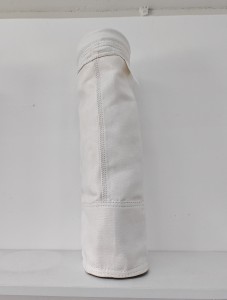
Glass fiber filter bag: Multi-layer composite structure helps achieve efficient filtration
Modern medium-efficiency bag filters made of glass fiber usually adopt a carefully designed multi-layer composite structure. Each layer of material plays a unique role, jointly ensuring efficient filtration and long-term use.
(1) Base layer: The core of filtration
The base layer is made of non-woven fabric formed by needle-punching fine-diameter glass fibers. It is the main part of the filtration. The fineness, porosity and thickness of the fibers in this layer have a direct impact on the filtration accuracy and dust holding capacity. The thickness of high-quality glass fiber needle-punched felt is generally controlled at 1.8 – 2.5mm, and the air permeability is between 80 – 120L/m²·s. Fine-diameter glass fibers formed by needle-punching form a three-dimensional network structure, which can effectively intercept most particulate matter. The finer fiber diameter helps to improve the capture efficiency of fine particulate matter, but it will correspondingly increase the initial resistance. Therefore, in practical applications, the fiber diameter and other parameters need to be optimized according to the dust characteristics and system air volume to achieve the best filtration effect.
(2) Reinforcement layer: Enhancing strength and stability
The reinforcement layer usually uses high-strength glass fiber mesh fabric or polyester base fabric, with a weight of 80 – 120g/m². It is usually placed between or on one side of the base layer. The existence of this layer significantly enhances the tensile strength and dimensional stability of the filter material. Relevant test data show that adding the reinforcement layer can increase the breaking strength of the filter material by 50% – 80%. In industrial dust removal systems, pulse cleaning is a common cleaning method, and the filter bags need to withstand the mechanical stress of the pulse airflow. The addition of the reinforcement layer enables the filter bags to better resist such mechanical stress, effectively preventing the bags from cracking, deforming, etc. during cleaning, and prolonging the service life of the filter bags, ensuring the normal operation of the dust removal system.
(3) Surface treatment layer: Improving surface properties
The surface treatment layer applies chemical agents such as PTFE or silicone oil by immersion or spraying to improve the surface properties of the filter material. The common addition amount of the treatment agent is 5% – 15% of the filter material weight. After treatment, the water repellency angle of the filter material can reach above 130°, and the dust shedding rate increases by 30% – 50%. Glass fibers have the disadvantages of high brittleness and poor bending resistance. The surface treatment technology effectively solves these problems. For example, PTFE immersion treatment can make the polytetrafluoroethylene emulsion penetrate the surface of the fibers, forming a micrometer-level coating, which not only significantly improves the flexibility and chemical stability of the filter material, but also raises the usage temperature of the filter material to 280℃, while reducing the surface energy and making the dust accumulation easier to remove; silicone oil treatment can also improve the surface properties of the filter material to some extent, enhancing its anti-fouling ability.
-
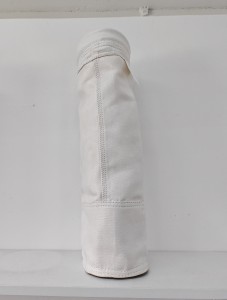
Glass fiber filter bags: The backbone of industrial dust removal
Among the numerous stages in industrial production, dust pollution has always been a pressing issue that needs to be addressed urgently. From the kilns in cement manufacturing to the blast furnaces in steel smelting, a large amount of dust is discharged along with the exhaust gas, causing severe pollution to the environment and posing a threat to the health of workers. In this battle against dust, fiberglass filter bags, with their outstanding performance, have become a pillar in the field of industrial dust removal.
Foundation laid by superior performance
The main material of fiberglass filter bags is glass fiber, which endows the filter bags with many excellent characteristics.(1) Outstanding high-temperature resistance
The softening point of glass fiber is as high as 550℃, and its strength retention rate exceeds 90% even when used for a long time at 260℃. Through thermogravimetric analysis (TGA), it can be seen that glass fiber shows no significant quality loss before 500℃, while polyester fiber begins to decompose at around 250℃. This characteristic enables fiberglass filter bags to easily handle high-temperature smoke gas of up to 260℃ in industries such as steel and cement, operating stably in high-temperature environments and continuously exerting filtering effects without deformation or damage due to excessive temperature, thus ensuring the continuity of industrial production.
(2) Strong chemical inertness, corrosion resistance
Glass fiber is resistant to acid and alkali corrosion within the pH range of 2 – 11. It maintains good stability in acidic gas environments such as SOx and NOx. Relevant experiments show that after exposing the fiberglass filter material to 50% sulfuric acid mist for 48 hours, its strength retention rate remains above 85%, while polypropylene fiber has completely degraded at this time. This strong corrosion resistance makes fiberglass filter bags an ideal choice for industries with corrosive environments such as chemical and metallurgical industries. Even in harsh working conditions filled with various corrosive gases and chemicals, they can operate stably for a long time, effectively filtering dust, extending their service life, and reducing the cost of replacing filter bags for enterprises.
(3) Excellent electrical performance, anti-static
The volume resistivity of glass fiber is between 10¹² – 10¹⁴Ω·cm, effectively preventing static electricity accumulation. In industrial production, many dusts such as coal dust and aluminum powder are flammable and explosive. If the filter bag cannot effectively prevent static electricity, the resulting static sparks are likely to trigger explosion accidents. In contrast, the volume resistivity of polyester fiber is approximately 10⁹Ω·cm, more prone to generating static electricity. The anti-static characteristic of fiberglass filter bags provides safety guarantees for industrial production in flammable and explosive dust environments, significantly reducing safety risks.
(4) Deep filtration, high dust retention capacity
Fiberglass filter bags mainly rely on mechanical interception and diffusion deposition effects of the fiber mesh for deep filtration. Unlike coated filter materials that mainly perform surface filtration, fiberglass needle-punched felt has a higher dust retention capacity and a gentler resistance growth curve. In actual industrial applications, dust concentrations often fluctuate, and fiberglass filter bags can maintain stable filtering performance under fluctuating dust concentrations in such conditions, without a significant drop in filtration efficiency or a sharp increase in resistance due to short-term increases in dust volume, ensuring the stable operation of the dust removal system.
-
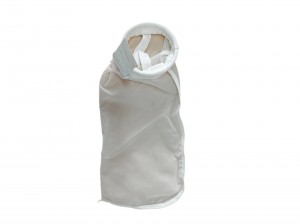
Nylon Water Filter Bag: Unmatched Performance Opens a New Era of Filtration
In today’s era of evolving water filtration technology, the nylon water filter bag stands out with its unique advantages, becoming the ideal choice for many industries to achieve efficient water filtration.
Nylon, as the core material for making filter bags, possesses numerous excellent properties. The high strength of nylon ensures that the filter bags have excellent mechanical performance, enabling them to withstand significant water pressure without being damaged. Additionally, its wear resistance, chemical resistance, and water resistance are all outstanding. When dealing with complex water quality environments, such as industrial wastewater containing acidic or alkaline substances, nylon water filter bags can perform stable filtration work thanks to their chemical corrosion resistance, without being affected by chemical substances and thus not shortening their service life.
The filtration accuracy range of nylon water filter bags is quite wide, typically ranging from 20 microns to 1000 microns. This diverse range of accuracy options meets the needs of different industries and different filtration stages. In some occasions where water quality requirements are relatively low, such as the pre-treatment of industrial wastewater, larger precision nylon water filter bags can quickly and effectively intercept large particles of impurities, such as sand and large suspended solids, laying the foundation for subsequent more precise treatment steps. In fields with extremely high water quality requirements, such as ultra-pure water production in the electronics industry and sterile water production in the pharmaceutical industry, smaller precision nylon water filter bags can precisely filter out microorganisms, bacteria, tiny particles, and colloids, ensuring that the produced water meets strict standards.
From the perspective of manufacturing process, nylon water filtration bags are usually made by precisely weaving nylon single filaments and processing them with special auxiliary materials. The weaving structure is tight and uniform, ensuring the stability and consistency of the filtration bag during the filtration process. Moreover, the surface of the nylon single filaments is smooth, which not only enables the liquid to pass through the filtration bag smoothly, improving the filtration efficiency, but also makes the impurities intercepted not easily adhere to the surface of the filtration bag. When cleaning is needed, the impurities can easily fall off, greatly enhancing the convenience of cleaning, and thus enabling the filtration bag to be reused multiple times, reducing the long-term usage cost.
In terms of practical application, nylon water filtration bags play a significant role in various industries. In the food and beverage sector, they are involved in the production of juices, edible oils, and wine. In juice production, they remove larger particles such as pulp during the coarse filtration stage, ensuring the smooth progress of the production process. Subsequently, in the fine filtration stage, they can also filter out small gelatinous particles, thereby improving the quality and taste of the juice. In the wine-making process, after initially filtering out impurities such as wine residue, nylon water filtration bags can further filter before bottling to prevent microbial contamination and extend the shelf life of the wine.
-
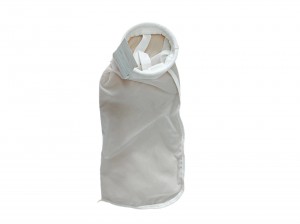
Nylon water filter bag: Highly efficient filtration, safeguarding water quality
In the field of water treatment, efficient filtration equipment plays a crucial role in ensuring the purity of water quality. The nylon water filter bag, as a highly performing filtration product, is widely used in various water filtration scenarios.
The nylon water filter bag is made of high-strength nylon material and its unique weaving process gives it many advantages. Firstly, its excellent compressive strength ensures that it does not deform even under high water pressure, maintaining a stable filtration effect. Whether in large-scale water treatment in industrial production or small-scale filtration systems in households, this stability is of vital importance.
Secondly, the surface of the nylon water filter bag is smooth, which makes it easy to clean. When the filter bag traps a large amount of impurities, simply rinsing or using an appropriate cleaning method can quickly restore its filtration performance, and it can be reused. This not only significantly reduces the usage cost but also aligns with the environmental protection concept.In terms of filtration accuracy, the nylon water filter bag can meet different requirements. It usually has multiple precision specifications available, ranging from coarse filtration to a certain degree of fine filtration. In some less stringent pre-filtration stages, such as the preliminary treatment before industrial wastewater discharge, the nylon water filter bag can quickly intercept large particles in the water, such as sand, fibers, and plastic blocks, reducing the burden on subsequent deep treatment. In some scenarios with higher water quality requirements, such as the initial filtration stage in the preparation of ultra-pure water for electronic industries, it can also play an important role in filtering out residual tiny particles, colloids, and other impurities, ensuring that the water entering the subsequent treatment process meets certain standards.
In practical application scenarios, the nylon water filter bag demonstrates strong applicability. In the pre-filtration stage of water treatment, whether in municipal sewage treatment plants for the initial treatment of raw water or in industrial internal circulation water systems for impurity removal, the nylon water filter bag can work efficiently. In the petrochemical industry, it can be used to treat various wastewater produced during the production process, ensuring that the discharged water meets environmental protection requirements, and can also filter some process water for use in subsequent treatment processes, ensuring the smooth operation of production.
In the light industry, food and beverage sectors, the nylon water filter bag is indispensable. For example, in the juice production process, it can remove large particles such as pulp and residue in the coarse filtration stage, ensuring the smoothness of the subsequent production process. In wine brewing, it can remove impurities such as wine residue in the initial filtration stage, improving the quality of the wine.
In addition, in solid-liquid separation and treatment in fields such as metallurgy, electronics, and pharmaceuticals, the nylon water filter bag also has wide applications. In the water treatment process of the biopharmaceutical industry, it can filter out possible micro-impurities such as microorganisms and bacteria in the water, providing pure water for drug production, ensuring the quality and safety of drugs.
The nylon water filter bag, with its outstanding performance, wide applicability, and good cost-effectiveness, has become a highly favored filtration product in the water treatment field, safeguarding every drop of pure water for us. -
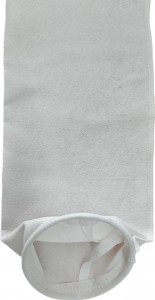
Water Filtration Bags: Innovation and Practical Guide
In the ever-evolving wave of water treatment technology, water filtration bags have always held a significant position. As an efficient and convenient filtering device, the technological innovation of water filtration bags has never ceased, providing better solutions for various water treatment needs in different industries.
Today, water filtration bags have made more breakthroughs in materials. Besides the traditional polypropylene, polyester, etc., new composite materials of water filtration bags have emerged. These composite materials combine the advantages of multiple materials, not only improving the filtration accuracy but also enhancing the temperature resistance, acid and alkali resistance, etc., allowing water filtration bags to function in more complex environments. For example, some composite material water filtration bags can maintain stable filtration effects at high temperatures, meeting the special needs of high-temperature industrial wastewater treatment.
In terms of structural design, water filtration bags have also seen significant improvements. Previously, water filtration bags were mostly simple bag-shaped structures, while now there are multi-ridged designs of water filtration bags. This design increases the filtration area, enhances the pollutant-capturing capacity, prolongs the service life of water filtration bags, reduces the replacement frequency, and saves costs for enterprises. At the same time, some water filtration bags adopt interface designs with better sealing performance, avoiding leakage during the filtration process and ensuring the stability of the filtration effect.
The application of water filtration bags cannot be separated from the correct usage methods. When choosing water filtration bags, one should select the appropriate material and precision based on water quality conditions and filtration requirements. When installing water filtration bags, ensure proper installation and good sealing to avoid affecting the filtration effect due to improper installation. During use, regularly check the usage status of water filtration bags. When the filtration efficiency decreases or the pressure difference increases, replace the water filtration bags in time to ensure the normal operation of the water treatment system.
In addition, the maintenance and care of water filtration bags are also very important. For washable water filtration bags, follow the correct methods for cleaning to remove impurities on the surface and restore their filtration performance. For disposable water filtration bags, do a good job in waste disposal to avoid environmental pollution.
With the continuous improvement of environmental awareness, water filtration bags play an increasingly important role in water resource recycling. Efficient water filtration bags can treat industrial wastewater, domestic sewage, etc., and reuse them, improving water resource utilization and reducing sewage discharge, contributing to the environmental protection cause.
In conclusion, water filtration bags, with their continuous technological innovation and practical performance, have a very broad application prospect in the field of water treatment. Correct selection, use, and maintenance of water filtration bags can make them function better, providing better water quality guarantees for our production and life.
-
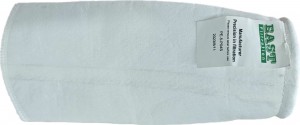
The wide application of water filtration bags: Protecting every drop of water in life and industry
The wide application of water filtration bags: Protecting every drop of water in life and industry
Water, as the source of life, plays an indispensable role in our daily life and industrial production. To ensure the purity and safety of water, water filtration bags are indispensable as a powerful assistant. With their efficient filtration performance and diverse features, water filtration bags have been widely applied in numerous fields and have become a solid defense line for protecting every drop of water.In the electronics industry, water filtration bags play a crucial role. The manufacturing of electronic components has extremely high requirements for water quality. Even the slightest impurities can affect the performance and quality of electronic products. For instance, during chip manufacturing, ultra-pure water is used to clean the surface of chips to ensure high precision and stability of the chips. Water filtration bags can precisely filter out particles, microorganisms, and organic substances in the water, providing nearly perfect pure water for chip manufacturing. At the pre-treatment stage of process water, water filtration bags also play an important role, removing large particles and colloidal substances in the water, reducing the burden on subsequent deep treatment equipment and improving the operational efficiency of the entire water treatment system. Moreover, in aspects such as tape coating agents and air pre-filtration, water filtration bags also provide reliable guarantees for the production environment of the electronics industry, ensuring the stable operation of electronic equipment and the reliability of product quality.
The food and beverage industry is closely related to our daily lives, and water filters are a crucial part in ensuring food safety and beverage quality. In the processing of products such as fruit juice, mineral water, milk, beer, brewing, vinegar production, and edible oil, water is an indispensable raw material. Water filters can effectively remove impurities, microorganisms, and odors from water, ensuring the taste and quality of the products. For example, in the production of mineral water, water filters can filter out mineral particles and microorganisms in the water, making the mineral water clearer and purer, and meeting national hygiene standards. In the brewing process of beer, water filters can remove impurities and odors from the water, providing high-quality water sources for the fermentation of beer, ensuring that the beer has a rich and fragrant taste. At the same time, the material of water filters complies with food safety standards and will not cause any pollution to food and beverages, providing consumers with safe and reliable products.
The chemical industry is a field with extremely strict requirements for water quality. Water filter bags play an irreplaceable role in this industry. During the manufacturing and processing of products such as latex, resin dyes, lubricants, oil agents, varnishes, petroleum, phosphate coatings, chemical drugs, and hot solvents, water filter bags can remove impurities, particles, and microorganisms from the water, ensuring the quality and stability of chemical products. For example, in petrochemical production, water filter bags are used to treat the circulating water and wastewater during the production process, removing oil stains, suspended solids, and heavy metal ions, achieving water resource recycling and reducing environmental pollution. In the manufacturing of chemical drugs, water filter bags can ensure the purity of the production water, avoiding the impact of impurities on drug quality, and guaranteeing the safety and effectiveness of the drugs.
The requirements for water quality in the biopharmaceutical industry have reached an extreme level. Water filter bags have become an important barrier to ensure the quality of drugs and the health of patients. In the processing and treatment of traditional Chinese medicine filtration, medical water, rinsing water, high-viscosity substances in biology and fermentation, cosmetics, etc., water filter bags can efficiently remove microorganisms, heat sources, and impurities from the water, ensuring that the water used in the drug production process meets strict quality standards. For example, in the production of injections, water filter bags can filter out bacteria and viruses from the water, ensuring the asepsis and safety of the injections. In the biological fermentation process, water filter bags can remove impurities and microorganisms from the water, providing a favorable environment for the growth of microorganisms and improving the fermentation efficiency and product quality.
Environmental protection is an important issue in today’s society. Water filter bags play a positive role in industrial and domestic water treatment, textile and paper wastewater treatment, metal cutting fluid treatment, and cleaner filtration. In industrial and domestic water treatment, water filter bags can remove impurities and pollutants from water, improve water quality, and meet the water needs for daily life and industrial production. In textile and paper wastewater treatment, water filter bags can filter out fibers, dyes, and suspended substances in wastewater, achieving compliant discharge or recycling of wastewater, and reducing environmental pollution. In metal cutting fluid treatment, water filter bags can remove impurities and metal particles from cutting fluids, extend the service life of cutting fluids, and reduce production costs. In cleaner filtration, water filter bags can remove impurities and microorganisms from cleaners, ensuring the quality and performance of cleaners.
The automotive industry, as an important part of modern manufacturing, also cannot do without the support of water filter bags. In processes such as coating, paint filtration, and paint application, water filter bags can remove impurities and particles from the water, ensuring the quality of coating and the appearance of the coating. For example, during the car painting process, water filter bags can filter out impurities and bubbles in the water, making the painting more uniform and smooth, and improving the appearance quality of the car. At the same time, water filter bags can also protect the painting equipment, extend its service life, and reduce maintenance costs.
The wide application of water filtration bags in various fields fully demonstrates their significant role in ensuring water quality, promoting production, and protecting the environment. It is like a dedicated guardian, safeguarding the purity and safety of every drop of water in every corner of our lives and industrial production. With the continuous advancement of technology and the increasing demands for water quality, the technology and performance of water filtration bags will also be continuously improved, contributing more to creating a better life and a sustainable future for us. -
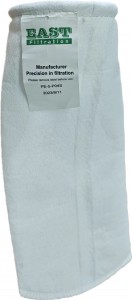
Water Filter Bags: A Key Line of Defense in Water Treatment
In today’s era where requirements for water quality are increasingly stringent, water filter bags, as core components in the water treatment process, play a pivotal role. Whether it is ensuring the smooth progress of industrial production or safeguarding the water safety in our daily lives, water filter bags silently undertake the task of filtering impurities and purifying water quality.The working principle of water filter bags is based on a precise physical filtration mechanism. When water flows through the filter bag, its unique fiber structure, like a fine mesh, can effectively intercept various impurities in the water, including suspended particles, colloidal substances, microorganisms, and other pollutants. These impurities are trapped inside the filter bag, while the purified water passes through smoothly, thus achieving efficient separation of water and impurities.Its filtration precision can be accurately adjusted according to different application needs, ranging from a few microns to hundreds of microns, which can meet the filtration requirements of various complex water qualities. For example, in the electronics industry, for the preparation of ultrapure water, filter bags need to have extremely high filtration precision to remove extremely small particle impurities in the water and ensure the production quality of electronic products; in some industrial fields with relatively low water quality requirements, such as textile printing and dyeing wastewater treatment, filter bags can quickly filter out large particle suspended solids in the water through larger pores, laying the foundation for subsequent advanced treatment.There is a wide variety of material choices for water filter bags, and each material has unique performance characteristics to adapt to different working environments and filtration needs. Common materials include polypropylene (PP), polyester (PE), nylon, and stainless steel. PP material filter bags have excellent acid and alkali resistance, strong chemical stability, can work stably in various chemical corrosion environments, and have relatively low cost, so they are widely used in chemical, pharmaceutical and other industries; PE material filter bags are known for their excellent wear resistance and good high-temperature resistance, can be used for a long time under high-temperature and high-wear working conditions, and are often used in petroleum, metallurgy and other fields; nylon material filter bags have high filtration precision and significant interception effect on tiny particles, and are often used in food and beverage, biopharmaceutical and other industries with extremely strict water quality requirements; stainless steel filter bags have comprehensive advantages such as high strength, corrosion resistance, and high-temperature resistance, and are suitable for some extremely harsh working environments, such as the filtration of drainage from high-temperature and high-pressure chemical reaction kettles.In practical applications, water filter bags show many incomparable advantages. Firstly, their filtration efficiency is extremely high, which can quickly and effectively remove impurities in water, greatly shortening the time of water treatment and improving production efficiency. Secondly, water filter bags have strong dirt-holding capacity, can hold a large number of impurities, reduce the frequency of frequent replacement of filter bags, and lower maintenance costs and labor intensity. Moreover, the installation and replacement of water filter bags are simple and quick, without the need for complex tools and professional skills, even non-professionals can easily complete, which provides convenience for their wide application in various occasions. In addition, water filter bags also have good environmental performance, and their materials are usually recyclable, reducing environmental pollution and conforming to the concept of sustainable development. -
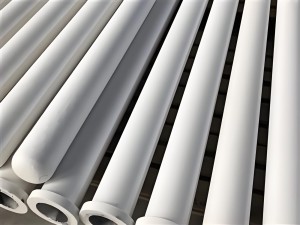
Purefrax® High Temperature Fiber Dust-Collecting Filter Tube
Core features:
Temperature resistance: Can operate continuously at 750℃, and withstand a temperature of 900℃ for an instant.
Filter performance: Pre-sprayed to form an embedded dust cake, achieving high filtration accuracy at the HEPA level, with 99% of particulate matter filtered on the surface. Actual performance shows that dust control can reach below 5mg/Nm³.
Service life: Up to 5 years or more.
Material and structure: Composed of silicic acid aluminum fibers and inorganic adhesives, resistant to acid and alkali corrosion; porosity > 80%; single unit weight is only 8.5kg, lower than similar products.rincipal Component Percentage Shape Dimensions Parameters Al₂O₃ 30% Length L MAX = 3000mm (customizable) SiO₂ 70% Outer Diameter O.D. = 150mm (customizable) - - Color White - - Density 370kg/m³ - - Long-term operating temperature ≤800℃ - - Filtering speed 0.8~1.2m/min - - Typical particulate emission ≤5mg/Nm³ -

Ceramic Filters: The “Purification Experts” in Harsh High-Temperature Environments
Ceramic Filters: The “Purification Experts” in Harsh High-Temperature Environments
In the field of industrial dust removal, ceramic filters have become the core equipment for purifying high-temperature flue gas and corrosive gases due to their outstanding high-temperature resistance and corrosion resistance. They play an irreplaceable role in demanding industrial conditions such as waste incineration, coal-fired power generation, and metallurgy.1. Material and Structural Characteristics
The core filter materials of ceramic filters mostly use ceramic materials such as silicon carbide (SiC), aluminum oxide (Al₂O₃), and corundum. These materials have three significant advantages:
High-temperature resistance: The long-term operating temperature can reach 800-1200℃, and the instantaneous temperature resistance even exceeds 1400℃. It can directly handle high-temperature flue gas without the need for additional cooling equipment, reducing energy loss.Chemical stability: It has strong resistance to corrosive media such as acids, alkalis, and organic solvents. It is not easily eroded in sulfur-containing flue gas (such as from coal-fired power plants) and chlorine-containing exhaust gas (from waste incineration).
High mechanical strength: Excellent in compression and impact resistance, capable of withstanding the high-pressure air flow impact during pulse cleaning (usually 0.5-0.8MPa), and not prone to damage.
Its structure is mostly in the form of honeycomb or tube-like. The honeycomb filter is composed of hundreds of parallel micro-porous channels. The inner walls of the channels are covered with breathable holes with diameters ranging from 1 to 50 μm. The smoke gas flows into the channels, and the dust is retained on the hole walls. The clean gas passes through the micro-pores and is discharged. The tubular filter is similar to a bundle of ceramic tubes. The outer walls of the tubes are the filter layer. The dusty gas flows into the tubes from the outside, and the dust adheres to the tube walls. During cleaning, compressed air is sprayed from the inside of the tubes in the opposite direction to achieve dust removal. -
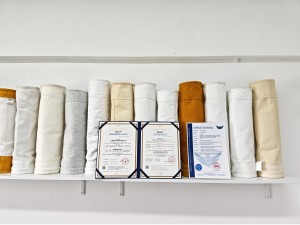
Working Principle of Anti-static Dust Filter Bags
In order to effectively solve the problem of static electricity, anti-static dust filter bags adopt special designs and materials. Their main working principle is to form a conductive network by mixing conductive fibers, such as stainless steel fibers, carbon fibers, or conductive polymer fibers, into the filter material. When static electricity is generated during the dust filtration process of the filter bag, these conductive fibers can quickly conduct away the static charge, preventing the static electricity from accumulating on the surface of the filter bag. At the same time, some anti-static dust filter bags also undergo anti-static treatment on the surface of the filter material, such as using anti-static coatings, to further reduce the surface resistance of the filter bag and enhance its static conductivity. This two-pronged approach enables anti-static dust filter bags to continuously and stably play an anti-static role in complex industrial environments, providing a strong guarantee for the safe operation of dust removal systems.Wide Range of Application IndustriesAnti-static dust filter bags are widely used in many industries.- Chemical Industry: The chemical production process involves a large number of flammable and explosive chemicals and dust, such as organic dust generated in organic synthesis workshops and light oil mist in petrochemical plants. Once these substances encounter electric sparks, they are extremely likely to cause explosions and fires. Anti-static dust filter bags can effectively filter dust and eliminate static electricity hazards in all aspects of chemical production, such as tail gas treatment of reaction kettles and workshop ventilation and dust removal, ensuring the safe and stable operation of chemical production.
- Coal Industry: A large amount of coal dust is generated during coal mining, processing, and transportation. Coal dust is not only flammable but also has a higher explosion risk in relatively closed environments such as underground mines. Anti-static dust filter bags are widely used in the ventilation systems of coal mines and the dust removal equipment of coal preparation plants, etc., which can timely filter coal dust, prevent coal dust explosions caused by static electricity, and protect the lives of coal mine workers and the smooth progress of coal mine production.
- Metal Processing Industry: During the production, processing, and storage of metal powders such as aluminum powder and magnesium powder, the friction between metal powders and equipment, pipelines, etc. is extremely likely to generate static electricity. These metal powders are highly flammable and explosive, and once an explosion occurs, the consequences are unthinkable. Anti-static dust filter bags play a key role in the workshop dust removal systems and dust collection equipment of the metal processing industry, being able to quickly conduct away static electricity and efficiently filter metal dust, building a solid defense line for the safety production of the metal processing industry.
- Grain Processing Industry: A large amount of dust is generated during the storage, transportation, and grinding of grains, such as flour, starch, and grain dust. These dusts have a high explosion risk when mixed with air in a closed environment. Take flour mills as an example. During the operation of equipment such as flour mills and dust collectors, the friction between dust and equipment components is likely to generate static electricity. Anti-static dust filter bags can effectively eliminate static electricity hazards, ensure the safe production of grain processing enterprises, and prevent dust explosion accidents.
Outstanding Performance Advantages- Excellent Safety Performance: The most core advantage of anti-static dust filter bags lies in their excellent anti-static performance, which can effectively reduce the risk of dust explosions and create a safe production environment for enterprises. By conducting away static electricity in a timely manner, it avoids fire and explosion accidents caused by static electricity, protecting the lives of employees and the property safety of enterprises.
- High Filtration Efficiency: In addition to the anti-static function, anti-static dust filter bags also perform well in terms of filtration efficiency. They can efficiently intercept various fine dust particles and also have a good filtering effect on smaller dust particles, ensuring that the discharged gas meets environmental protection standards and reducing dust pollution to the environment.
- Long Service Life: Due to the use of special materials and processes, anti-static dust filter bags have good wear resistance and corrosion resistance. Under normal use, their service life is longer than that of ordinary filter bags, reducing the frequency of filter bag replacement, lowering the maintenance costs and downtime of enterprises, and improving production efficiency.
- Strong Adaptability: Anti-static dust filter bags can adapt to various complex industrial environments. Whether it is a high-temperature, high-humidity environment or an environment containing corrosive gases, they can operate stably and maintain good anti-static and filtering performance. For example, in the high-temperature tail gas treatment of reaction kettles in some chemical enterprises, anti-static dust filter bags can effectively filter dust and eliminate static electricity in a high-temperature environment.
As an important device in the field of industrial dust removal, anti-static dust filter bags are of great significance for ensuring production safety and reducing environmental pollution. With the continuous development of industrial technology and the increasing requirements for environmental protection, the application prospects of anti-static dust filter bags will be even broader. Enterprises should fully recognize the importance of anti-static dust filter bags, and reasonably select and use anti-static dust filter bags according to their own production processes and dust characteristics, laying a solid foundation for the sustainable development of enterprises.